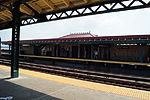University Heights Bridge

The University Heights Bridge is a steel-truss revolving swing bridge across the Harlem River in New York City. It connects West 207th Street in the Inwood neighborhood of Manhattan with West Fordham Road in the University Heights neighborhood of the Bronx. The bridge is operated and maintained by the New York City Department of Transportation. The bridge carries two lanes of traffic in each direction, along with a sidewalk on its southern side. The bridge has three masonry piers supporting the steel approach spans. The sidewalk features four shelters with cast-iron supports while the bridge deck has decorative iron railings and two stone pavilions. The bridge structure was originally installed further to the north, carrying Broadway across the Harlem River Ship Canal. It opened in 1895 as the Harlem Ship Canal Bridge and was relocated southward to University Heights in 1908. Over the following decades, the University Heights Bridge carried streetcar and bus service. By the late 20th century it was in disrepair. The New York City Landmarks Preservation Commission designated the University Heights Bridge as a city landmark in 1984, and it was completely rebuilt between 1989 and 1992.
Excerpt from the Wikipedia article University Heights Bridge (License: CC BY-SA 3.0, Authors, Images).University Heights Bridge
University Heights Bridge, New York Manhattan
Geographical coordinates (GPS) Address External links Nearby Places Show on map
Geographical coordinates (GPS)
| Latitude | Longitude |
|---|---|
| N 40.862777777778 ° | E -73.915 ° |
Address
University Heights Bridge
University Heights Bridge
10034 New York, Manhattan
New York, United States
Open on Google Maps





